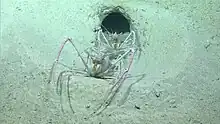| Acanthacaris caeca | |
|---|---|
.jpeg.webp) | |
 | |
| Scientific classification | |
| Domain: | Eukaryota |
| Kingdom: | Animalia |
| Phylum: | Arthropoda |
| Class: | Malacostraca |
| Order: | Decapoda |
| Suborder: | Pleocyemata |
| Family: | Nephropidae |
| Genus: | Acanthacaris |
| Species: | A. caeca |
| Binomial name | |
| Acanthacaris caeca Milne-Edwards, 1881[1] | |
Acanthacaris caeca is a species of deep-water lobster.[2][1] It was originally described under the name Phoberus caecus by Alphonse Milne-Edwards.[1][3] Lacking eyes, A. caeca is blind.[4]
Habitat
Acanthacaris caeca are found in the Caribbean Sea and in the Gulf of Mexico.[3][5][6] They are generally found in burrows between 550 and 825 m (1,800 and 2,710 ft), but they can be found as deep as 880 m (2,890 ft) and as shallow as 290 m (950 ft).[3] They burrow exclusively in muddy environments, and the burrows are 10 to 20 cm (4 to 8 in) deep.[7]
See also
- Acanthacaris tenuimana, the only other species in Acanthacaris
References
- 1 2 3 Milne-Edwards, Alphonse (1881). "Description de Quelques Crustacés Macroures Provenant des Grandes Profondeurs de la Mer des Antilles". Annales des Sciences Naturelles (in French). 11 (6): 1–16.
- ↑ Felder, Darryl L.; Álvarez, Fernando; Goy, Joseph W.; Lemaitre, Rafael. "Decapoda (Crustacea) of the Gulf of Mexico, with Comments on the Amphionidacea". In Felder, Darryl L.; Camp, David K. (eds.). Gulf of Mexico Origin, Waters, and Biota (PDF). Vol. I, Biodiversity. pp. 1019–1104. Archived (PDF) from the original on 6 October 2021. Retrieved 27 August 2023 – via the Natural History Museum of Los Angeles County.
- 1 2 3 Holthuis, Lipke B. (December 1974). "Biological Results of the University of Miami Deep-Sea Expeditions. 106. The Lobsters of the Superfamily Nephropidea of the Atlantic Ocean (Crustacea: Decapoda)". Bulletin of Marine Science. 24 (4): 723–884.
- ↑ Wahle, Richard A.; Tshudy, Dale; Cobb, J. Stanley; Factor, Jan; Mahima, Jaini (20 March 2012). "Infraorder Astacidea Latreille, 1802 p.p.: the marine clawed lobsters". In Schram, Frederick; von Vaupel Klein, Carel (eds.). The Crustacea. Treatise on Zoology - Anatomy, Taxonomy, Biology. Vol. 9B. Brill. pp. 59–60. doi:10.1163/9789047430179_003. ISBN 978-90-04-17673-7.
The absence of eyes in the deepwater Acanthacaris caeca (A. Milne-Edwards, 1881) suggests either a more cryptic existence, or a greater dependence on the other sensory modes.
- ↑ Silva, K. C. A.; Cruz, R.; Cintra, I. H. A.; Abrunhosa, F. A. (January 2013). "Structure and diversity of the lobster community on the Amazon continental shelf". Crustaceana. 86 (9): 1084–1102. doi:10.1163/15685403-00003227. S2CID 85075976.
- ↑ Briones-Fourzán, P.; Lozano-Álvarez, E.; Vázquez-Bader, A.R.; Gracia, A. (2020). "Deep-Sea Lobsters (Polychelidae and Nephropidae) from the Continental Slope of the Southern Gulf of Mexico: Distribution and Morphometric Relationships". In Hendrickx, Michel E. (ed.). Deep-Sea Pycnogonids and Crustaceans of the Americas. Springer Nature. pp. 311–341. doi:10.1007/978-3-030-58410-8_13. ISBN 978-3-030-58409-2.
- ↑ Correa, Thiago B.S.; Eberli, Gregor P.; Grasmueck, Mark; Reed, John K.; Correa, Adrienne M.S. (October 2012). "Genesis and morphology of cold-water coral ridges in a unidirectional current regime". Marine Geology. 326–328: 14–27. doi:10.1016/j.margeo.2012.06.008.
External links
 Media related to Acanthacaris caeca at Wikimedia Commons
Media related to Acanthacaris caeca at Wikimedia Commons
This article is issued from Wikipedia. The text is licensed under Creative Commons - Attribution - Sharealike. Additional terms may apply for the media files.